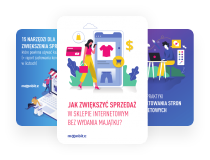Artificial intelligence in e-commerce: the impact of technology on the evolution of chatbots
Chatbots based on artificial intelligence are not a new concept at all. SmarterChild, the first AI chatbot, was created in 2000 and was available to all AOL Instant Messenger users. SmarterChild covered as much as 5% of traffic in AIL and had 30 million users on the buddy list. 20 years ago, the chatbot was an unprecedented innovation, but with the advent of intelligent assistants, the role of chatbots in user entertainment and education has diminished.
The growth of artificial intelligence, on the other hand, fostered the rise of chatbots not limited to answers written in the code, but which can recognize separate inquiry words and find the appropriate response. Most often this type of chatbot can be met in customer service, where computer programs replace employees to conduct simple conversations with potential consumers. Users usually prefer to talk to the chatbot, because in this case, they will receive relevant information in a very short time. This increases customer satisfaction and makes them more decided on making a purchase or recommending the company to others.
Artificial intelligence not only affects how chatbots respond but also how they look and behave. At the CES 2020 conference STAR Labs (Samsung Technology and Advanced Research Labs) presented the NEON project - video chatbots that look like real people. Thanks to AI, "artificial humans" are able to show emotions and conduct conversations, educating on a selected topic.
The goal of the project is to create a similarity with people, increasing the comfort of communication between the program and the user. However, the creators of the project say that NEON will never be able to replace a human or even an intelligent assistant because they are limited to programmed functions and scope of knowledge.
AI chatbots in online stores
Chatbots based on artificial intelligence implement Natural Language Processing (NLP) technology, which involves analyzing, understanding and generating speech, similar to that used by people for interpersonal interactions. With NLP, chatbots are able to maintain a conversation without using stiff and strange phrases, although the technology is not yet developed enough so that the user cannot recognize that he is talking to the machine.
Chatbots still cannot recreate interpersonal interactions with meticulous precision, but potential customers do not insist on talking to a real person. Users turn to customer service because they want to get the information they need instead of looking for it themselves and in most cases, it is not important whether the answer is given by an algorithm or a human.
The advantage of chatbots is also their access to conversations with users and the ability to learn from them. Although employees also have the ability to read all communication, the computer program will be able to process available information in a fraction of a second and improve their future interactions with potential customers based on that.
Despite the rapid development of chatbots, they will probably never replace a human being in interactions between the consumer and the brand, regardless of the level of technological advancement. Programs are useful when answering simple queries and requesting basic information from potential customers, but in situations that require assessing user behavior or giving advice, the insight of a real person is necessary.


